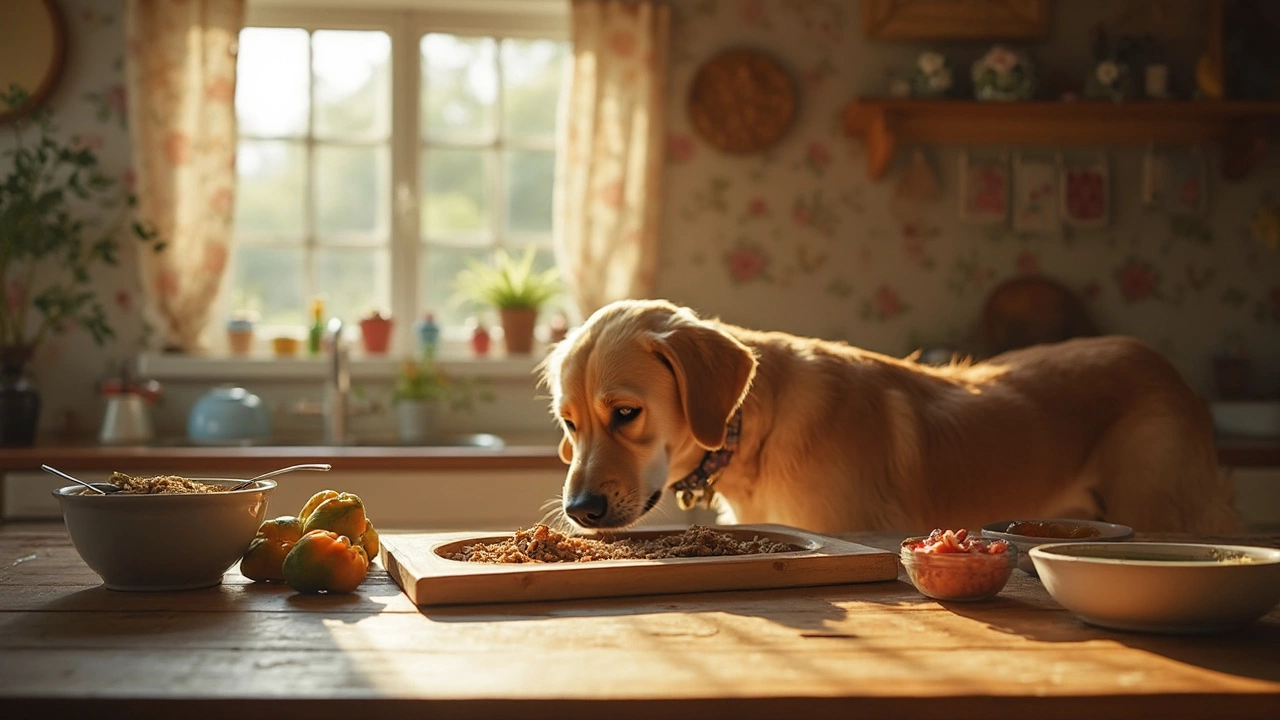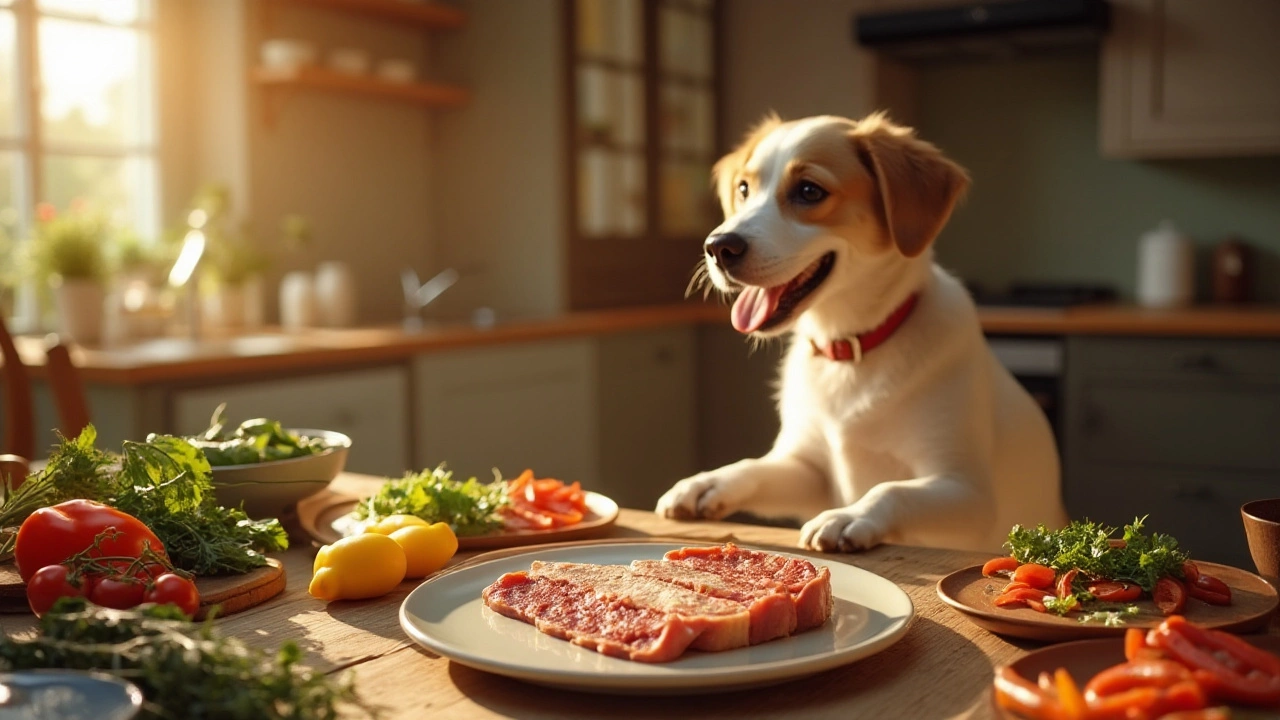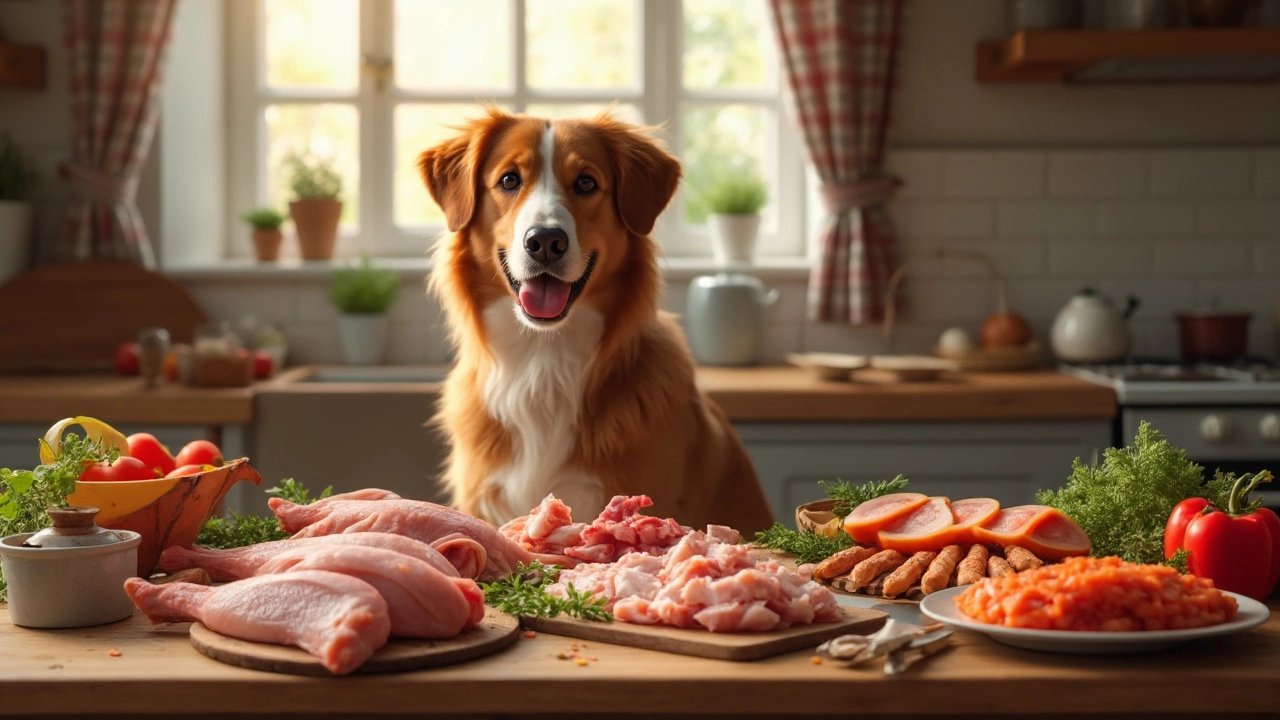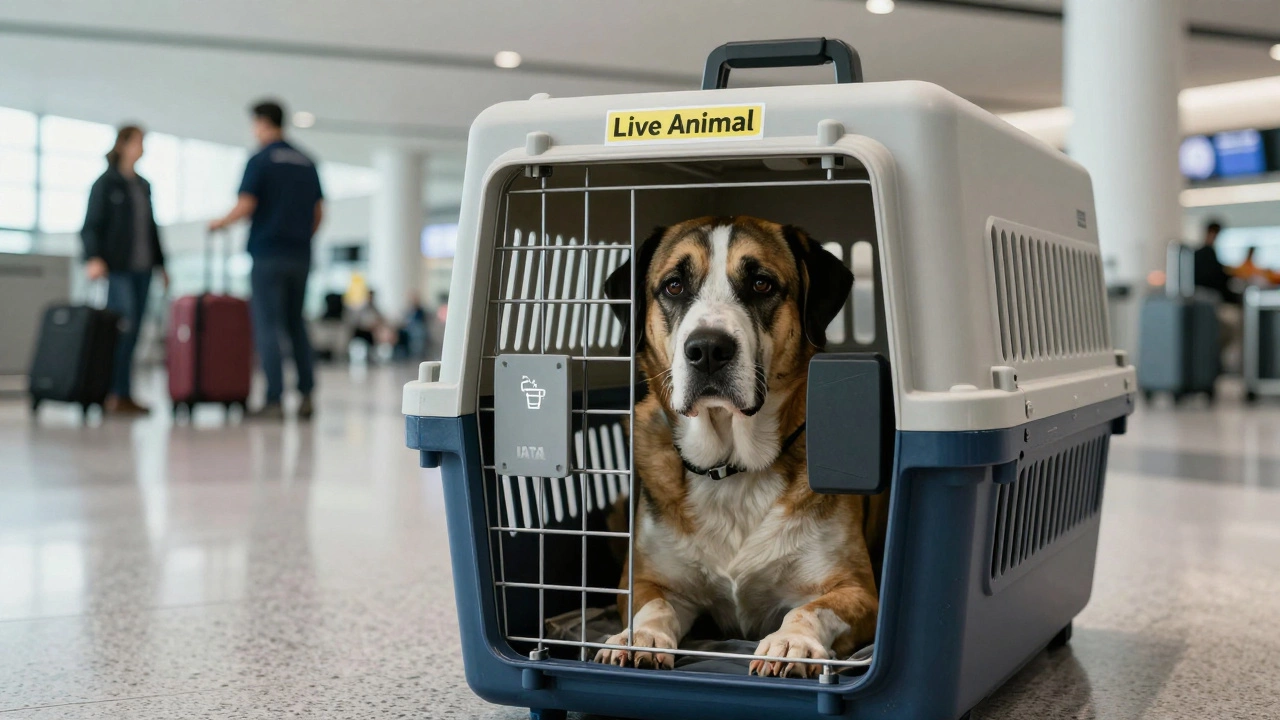Picking the right food for your furry friend is like choosing the best gadget for your smartphone—tons of options, but some clear front-runners. Let's talk about the big four types of dog food every pet owner should know: dry, wet, raw, and homemade. Each has its perks, and knowing these can help you make the best choice for your pooch.
Dry dog food, often packed in those huge bags you see at the store, is super convenient. It lasts ages and makes less mess, which is a win if you're constantly vacuuming up crumbs. Plus, it's great for your dog's teeth, like how crunchy snacks help keep our teeth free of gunk.
- Introduction to Dog Food Options
- Dry Dog Food: Convenience and Benefits
- Wet Dog Food: Taste and Texture
- Raw Dog Food: Natural and Wholesome
- Homemade Dog Food: Tailored Nutrition
- Choosing the Right Option for Your Dog
Introduction to Dog Food Options
So, you walk into a pet store or browse online, and you're hit with shelves stocked full of dog food brands, each promising they're the best. But what's really inside those bags or cans? Well, it generally boils down to four major types you should know to keep your pup happy and healthy: dry, wet, raw, and homemade.
Dry dog food, also known as kibble, is the most popular choice out there. It's affordable, easy to store, and doesn't spoil quickly. Imagine it like the cereal aisle of pet foods. Your dog might even get some dental benefits because, as they munch, they're scraping away at tartar buildup.
Wet dog food, often packed in cans, offers flavor and moisture that even the pickiest dogs can't resist. It's like serving up a special treat every meal, and it's particularly great for dogs that don't drink enough water. However, it needs to be refrigerated once opened, and leftovers can get messy.
Then there's raw dog food, the 'back to nature' choice. It's all about providing your dog with what their ancestors ate before pet food became a thing. Raw food enthusiasts say it's great for pets with allergies or sensitive stomachs. But, it can be costly and require careful handling to avoid contamination.
Homemade dog food lets you be the chef. You're in control of what goes into your pet's bowl, ensuring they get all the nutrients they need. However, it's essential to get your recipe from a trusted source to keep your dog's diet balanced. As Dr. Rebecca Remillard, a veterinary nutritionist, advises,
"Homemade diets must be carefully planned to avoid nutritional deficiencies."
Each option has its pros and cons. You might find that your dog's interest in their meals can vary as much as ours can with different cuisines. Reading up on each can help you make the best decision for your dog’s health, especially since good nutrition is at the heart of their wellbeing. That's something every pet parent wants, right?
Dry Dog Food: Convenience and Benefits
Dry dog food, also known as kibble, is probably what comes to mind first when you think of dog chow. It's no wonder, because it tops the list of convenience. It's easy to scoop, serve, and store, making day-to-day feeding a breeze. Plus, it's pretty cost-effective, which is a huge bonus for most pet parents.
Beyond the convenience factor, kibble offers some surprising health benefits. Those crunchy bites help scrub away plaque and tartar, acting like a toothbrush for your dog's chompers. This can cut down on trips to the vet for dental issues. And hey, who doesn't want fresh doggy breath?
Nutritionally, dry dog food often comes fortified with essential vitamins and minerals. Many quality brands ensure their dog food contains balanced nutrients, tailoring formulas to different life stages or dietary needs. You can find kibble catering to puppies, adults, seniors, and even dogs with special dietary requirements, like grain-free or high-protein variants.
Here’s a quick snapshot of why many go for dry food:
- Ease of use: Just scoop and serve.
- Long shelf life: Store it easily without it going bad quickly.
- Dental health: Helps with teeth cleaning.
- Available in options: Nutritional formulas for different dog needs.
According to a recent survey, about 60% of dog owners prefer dry dog food for its affordability and ease of use. So, if you're juggling a busy schedule, dry food can be a lifesaver without compromising your pup’s health.
| Benefits | Percentage of Dog Owners |
|---|---|
| Convenience | 70% |
| Cost Effectiveness | 50% |
| Dental Health | 40% |
Wet Dog Food: Taste and Texture
Imagine food so tasty that even the most stubborn dogs can't resist. That's wet dog food for you! Packed in cans or pouches, it's often the answer when a pup turns up its nose at dry kibble. The aroma and flavor of wet dog food generally make even the pickiest pooches wag their tails at mealtime.
Now, why does it work so well? For starters, the texture. If your dog isn't thrilled with the crunchy bits in dry dog food, the soft, moist nature of wet food could be their jam. It's also a lifesaver for older dogs with dental issues who's tired of all that chewing.
Here's a handy tip: wet dog food contains a lot of water, which can help up your dog's hydration, especially if they aren't big water drinkers. And for those on a diet, the moisture content makes them feel full with fewer calories. However, Dr. Julie Churchill from the University of Minnesota says all dog foods need vet approval when dealing with health issues. So, get your vet's advice if you're making changes.
"Wet dog food is often favored by pet owners because of its rich taste and high water content, which is great for hydration," says Dr. Julie Churchill.
Keep in mind, wet food does come with its pros and cons. It's messier and more expensive than dry food. Once opened, it needs to be refrigerated, and you can't leave it out for too long without it getting spoiled.
For those numbers folks out there, here's a quick look at the typical nutrient breakdown of wet food:
| Nutrient | Typical Content |
|---|---|
| Crude Protein | 8-12% |
| Moisture | 75-85% |
| Fat | 3-6% |
To wrap it up, wet dog food can be a delicious, hydrating choice for your dog. Just keep those leftovers in the fridge and, as always, get a thumbs up from your vet before switching things up.
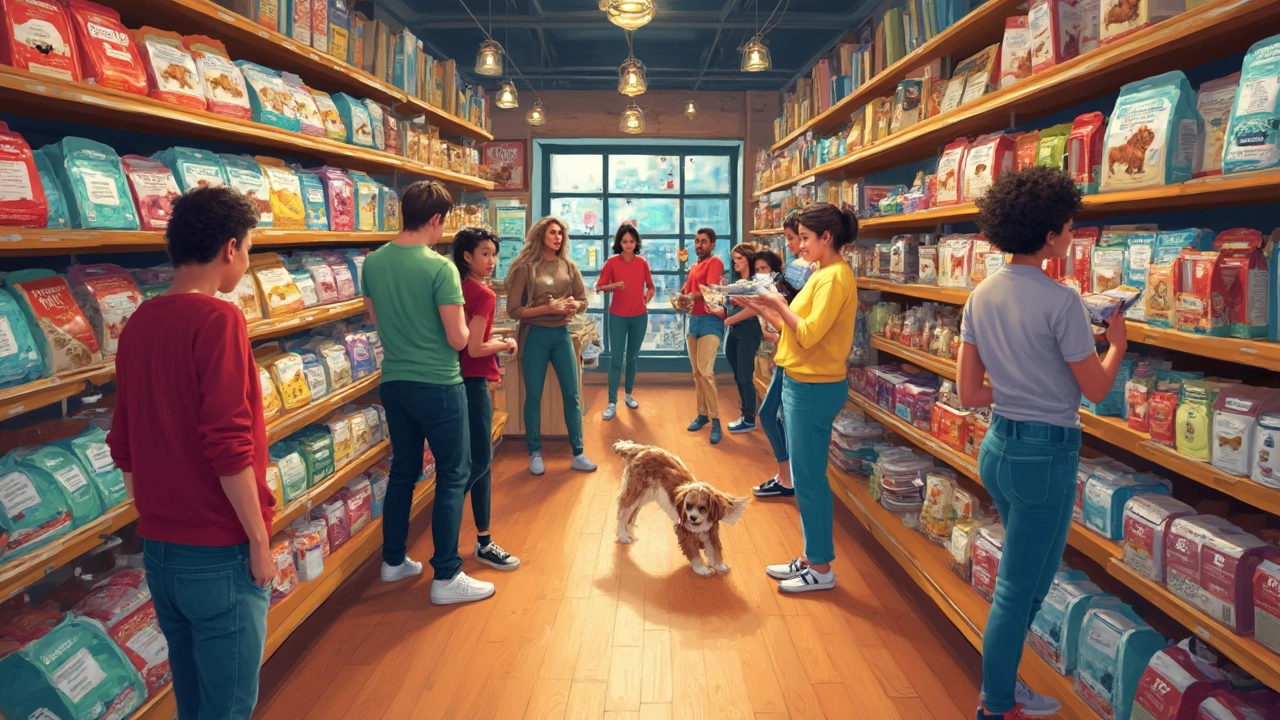
Raw Dog Food: Natural and Wholesome
Curious about the raw food craze for dogs? Well, it's not just a fad. Raw dog food, often called a raw or BARF (Biologically Appropriate Raw Food) diet, is all about mimicking what wild dogs and their ancestors used to eat. It usually includes raw meat, bones, fruits, and veggies. The idea is to go back to basics with a more natural approach to dog food.
One big plus of raw dog food is that it's packed with unprocessed, nutrient-rich ingredients. Proponents argue that this means more vitamins, minerals, and enzymes, which can help with everything from shinier coats to better energy levels. Some folks even say their dogs tend to have fewer allergies and better digestion. But, be ready for a bit more planning since meals need to be balanced to make sure your dog gets all the needed nutrients.
Now, let's not forget that handling raw food requires a bit more care. It's like when you're grilling up some burgers—hygiene is key. Always wash your hands thoroughly and make sure anything that touches raw meat is cleaned well. Plus, if you're feeding a puppy, pregnant dog, or an older pooch, it's best to chat with a vet first to avoid any hiccups.
But beware, not everyone's on board with this diet. Critics say there's a risk of harmful bacteria and that some dogs might not get a balanced diet. It's an idea to do your homework and maybe start small if you're considering switching.
For those who like a bit of data, here's a quick look at the basics components commonly found in raw dog food diets:
| Component | Typical Percentage |
|---|---|
| Meat | 60-80% |
| Bones | 10-15% |
| Organs | 5-10% |
| Vegetables & Fruits | 5-10% |
So, whether you're thinking about raw for the health perks or the back-to-nature vibes, it's worth considering all the angles. Dive into research and consult your vet to make sure it's the right call for your dog's needs.
Homemade Dog Food: Tailored Nutrition
Making homemade dog food is like cooking up a storm, tailored just for your pup! It's your chance to go full chef mode, ensuring every bite your dog eats is packed with the love and nutrients they need. The biggest win here is control—you decide the ingredients, making it a fantastic option for dogs with specific dietary needs or allergies.
When going the homemade route, it's crucial to balance proteins, carbohydrates, and healthy fats. Think lean meats like chicken or turkey, a small scoop of rice or oats, and a drizzle of fish oil. Veggies like carrots and peas add vitamins and fiber essential for pet nutrition. Keep in mind, though, not all human foods are dog-friendly. Avoid onions, garlic, and chocolate, to name a few.
Want to know if your dog's dinner is hitting all the right nutritional notes? Consider this simple recipe:
- 2 cups of cooked, boneless chicken or turkey
- 1 cup of cooked brown rice
- 1/2 cup of mixed vegetables (carrots, peas)
- 1 tablespoon of fish oil or olive oil
- Cool and serve portions as needed
When moving to homemade meals, chatting with your vet is crucial. They'll help ensure your recipe is nutritionally balanced, particularly if your dog has unique health concerns. Some folks find it handy to use supplements, like calcium and vitamins, to cover any nutritional gaps.
Feeding homemade means you're skipping the preservatives found in store-bought dog food. However, it does require more time and planning. Freeze big batches for convenience while keeping them fresh and tasty. A simple table below can serve as a handy reminder of some key foods dogs should avoid and the ones they can safely enjoy.
| Safe Foods | Avoid These |
|---|---|
| Apples (without seeds) | Grapes & Raisins |
| Pumpkin | Chocolate |
| Sweet Potatoes | Onions & Garlic |
Homemade meals are more than just food; they're a way to bond with your dog, knowing exactly what they're munching on. With a bit of prep and your vet’s blessing, you're well on your way to creating a diet that makes that tail wag like crazy!
Choosing the Right Option for Your Dog
So, you've got all these choices, and now comes the million-dollar question: which dog food should you go with? It’s not just about picking the trendiest option, but what works best for your pup's health and your lifestyle.
First off, consider your dog's specific needs. Is your dog super active or more of a couch potato? Active dogs might need a higher protein diet, which you can find in some raw dog food options. On the other hand, for older dogs or those with kidney concerns, a lower protein choice like wet dog food might be better.
Think about your convenience too. If you’re constantly on the go, dry dog food is probably your best friend because it’s easy to store and serve. For those who prefer knowing exactly what goes into their pet’s meals, homemade dog food offers complete transparency and lets you customize the nutrients.
- Budget Makes a Difference: Price can vary a lot between different types of dog food. For tight budgets, dry food is usually more affordable.
- Ingredient Preferences: Some dogs have allergies, so you might need to look into specific ingredients. Homemade dog food lets you tailor everything to avoid these allergens.
- Veterinarian's Advice: Don’t forget to chat with your vet. They can offer tailored advice based on your dog's unique health needs.
Here’s a quick comparison if you’re still stuck:
| Type | Convenience | Cost | Customizable |
|---|---|---|---|
| Dry Dog Food | High | Low | No |
| Wet Dog Food | Medium | Medium | No |
| Raw Dog Food | Low | High | Yes |
| Homemade Dog Food | Low | Varies | Yes |
Ultimately, the best choice depends on balancing your dog's needs, your budget, and how much time you can invest. It's all about making sure that tail keeps wagging happily!

